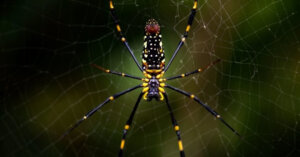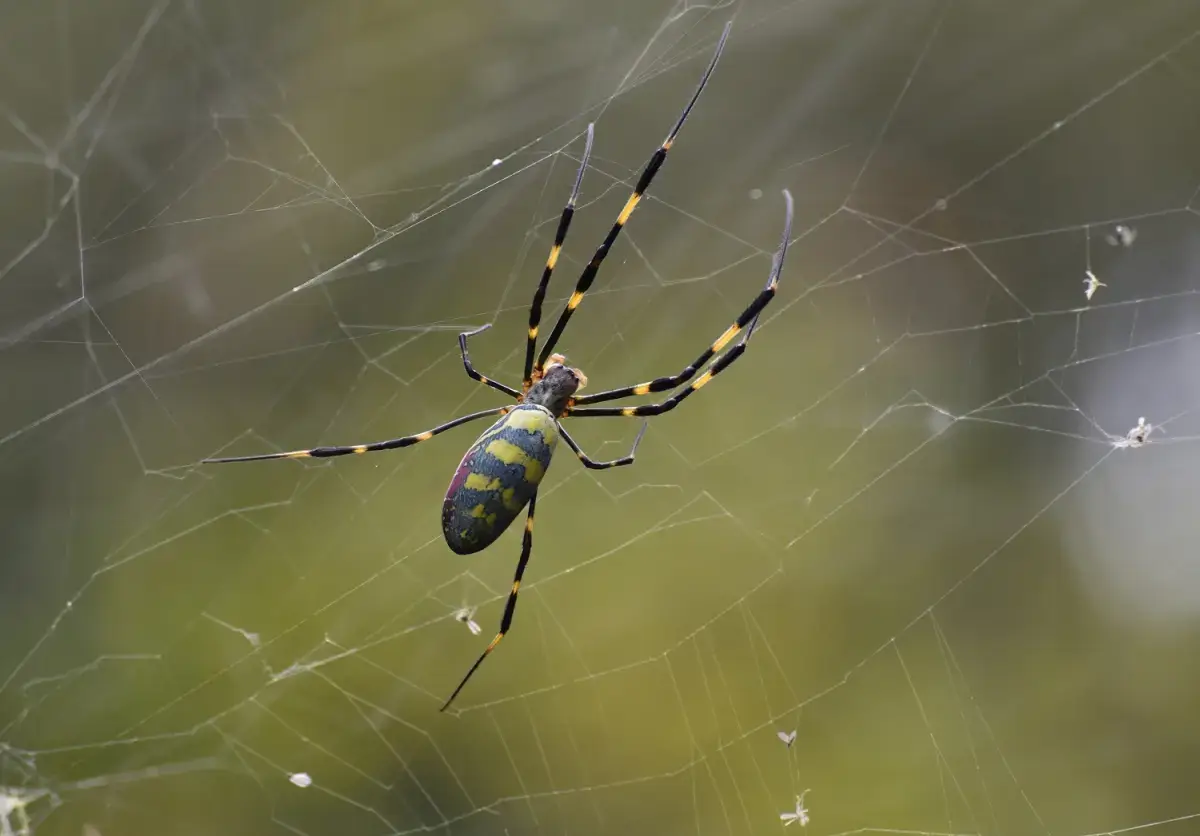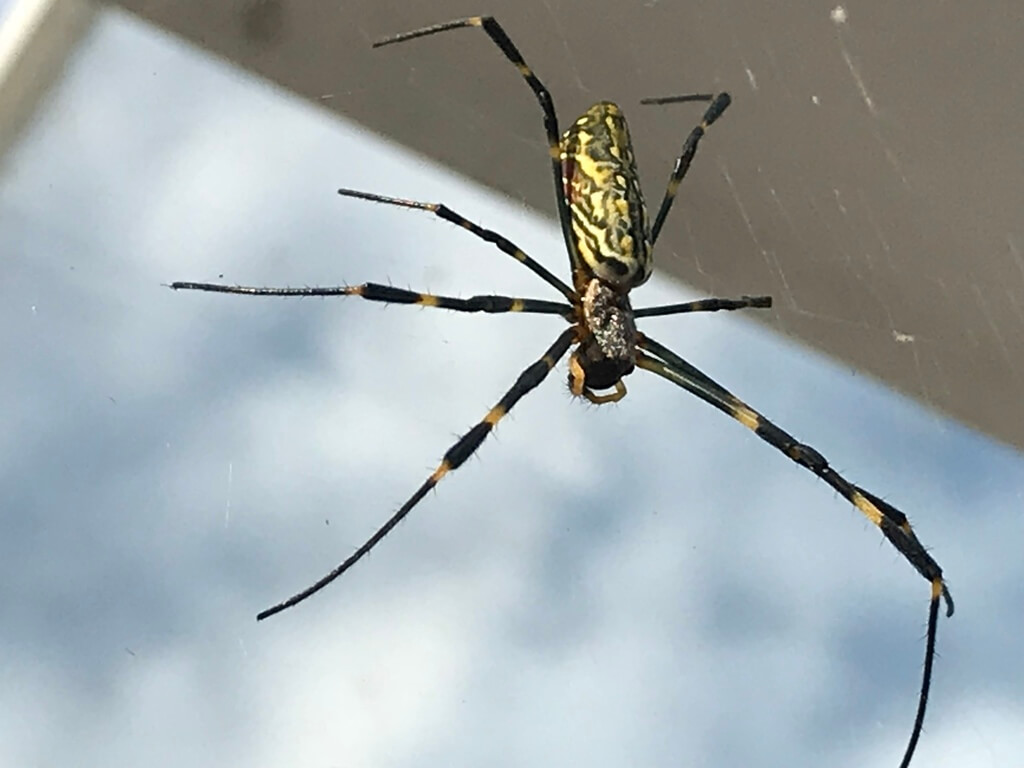The Joro Spider: Habitat, Characteristics, and Reproduction


Written and verified by the veterinarian and zootechnician Sebastian Ramirez Ocampo
The Trichonephila clavata, known as the joro spider, is a species of arachnid belonging to the Araneidae family. It’s characterized by its ability to spin large, resistant webs, in addition to possessing strong, striking body colors.
Despite being native to the Asian continent, specifically to countries such as Korea, Japan, and China, this spider has quickly invaded different regions of North America. Discover in the following lines the reason for this phenomenon, as well as its main characteristics and behavior.
Characteristics of the joro spider
As adults, the female of this species usually measures between 17 to 25 millimeters (7 to 10 inches), while the male only reaches 10 mm (0.4 inches) in length. This spider is easily identified by its yellow and black legs. In addition, you can see intense shades of green, yellow, and red on its abdomen.
Moreover, this arachnid is specialized in the construction of three-dimensional webs, which also reach great lengths. According to research published in the scientific journal Insects, they can support weights of up to 70 grams (3 oz) before collapsing.

In addition to the above, their webs have a shiny golden color, which makes them more striking for their prey to fall onto. According to a study shared in the journal Biomolecules, one of the components of their webs is xanthurenic acid, which, in addition to giving them their characteristic coloration, has antibacterial properties.
Habitat and diet
As described above, this spider is native to Asian countries such as China, Korea, Japan, and Taiwan. In these territories, it’s commonly found in forests, parks, or even residential areas. However, as we’ll mention below, this arachnid has been living in North America since approximately 2013. Moreover, its diet is based on the consumption of insects such as mosquitoes, flies and other Lepidoptera.
Reproduction of the joro spider
Mating usually occurs in the fall, when several males come to the webs of females to mate. After mating, the female builds a kind of cocoon on a tree and deposits 400 to 1500 eggs there. Once she has fulfilled her role of leaving offspring, the female dies at the beginning of winter, while the young emerge from her eggs in the spring.
An invasive species
The first sighting of the joro spider in the United States occurred in 2013, when several residents of the city of Hoschton in Georgia reported the presence of this arachnid in their homes. Since then, this species has been seen in other regions such as South Carolina and Atlanta. According to several experts, the spider may have been transported from the Asian continent via containers carried on cargo ships.

Although the joro spider doesn’t represent a risk to people as its venom is harmless, the main concern is about the consequences it may have on the native species of these regions. However, it’s not all bad news, as it has been seen consuming various types of crop-damaging pests such as brown bugs. In addition, some birds, such as the northern cardinal, have been reported to feed directly on prey left on the webs.
Finally, experts believe that the joro spider will continue to extend throughout the continent, since in addition to finding sufficient prey for its survival, it’s especially resistant to the cold.
The Trichonephila clavata, known as the joro spider, is a species of arachnid belonging to the Araneidae family. It’s characterized by its ability to spin large, resistant webs, in addition to possessing strong, striking body colors.
Despite being native to the Asian continent, specifically to countries such as Korea, Japan, and China, this spider has quickly invaded different regions of North America. Discover in the following lines the reason for this phenomenon, as well as its main characteristics and behavior.
Characteristics of the joro spider
As adults, the female of this species usually measures between 17 to 25 millimeters (7 to 10 inches), while the male only reaches 10 mm (0.4 inches) in length. This spider is easily identified by its yellow and black legs. In addition, you can see intense shades of green, yellow, and red on its abdomen.
Moreover, this arachnid is specialized in the construction of three-dimensional webs, which also reach great lengths. According to research published in the scientific journal Insects, they can support weights of up to 70 grams (3 oz) before collapsing.

In addition to the above, their webs have a shiny golden color, which makes them more striking for their prey to fall onto. According to a study shared in the journal Biomolecules, one of the components of their webs is xanthurenic acid, which, in addition to giving them their characteristic coloration, has antibacterial properties.
Habitat and diet
As described above, this spider is native to Asian countries such as China, Korea, Japan, and Taiwan. In these territories, it’s commonly found in forests, parks, or even residential areas. However, as we’ll mention below, this arachnid has been living in North America since approximately 2013. Moreover, its diet is based on the consumption of insects such as mosquitoes, flies and other Lepidoptera.
Reproduction of the joro spider
Mating usually occurs in the fall, when several males come to the webs of females to mate. After mating, the female builds a kind of cocoon on a tree and deposits 400 to 1500 eggs there. Once she has fulfilled her role of leaving offspring, the female dies at the beginning of winter, while the young emerge from her eggs in the spring.
An invasive species
The first sighting of the joro spider in the United States occurred in 2013, when several residents of the city of Hoschton in Georgia reported the presence of this arachnid in their homes. Since then, this species has been seen in other regions such as South Carolina and Atlanta. According to several experts, the spider may have been transported from the Asian continent via containers carried on cargo ships.

Although the joro spider doesn’t represent a risk to people as its venom is harmless, the main concern is about the consequences it may have on the native species of these regions. However, it’s not all bad news, as it has been seen consuming various types of crop-damaging pests such as brown bugs. In addition, some birds, such as the northern cardinal, have been reported to feed directly on prey left on the webs.
Finally, experts believe that the joro spider will continue to extend throughout the continent, since in addition to finding sufficient prey for its survival, it’s especially resistant to the cold.
All cited sources were thoroughly reviewed by our team to ensure their quality, reliability, currency, and validity. The bibliography of this article was considered reliable and of academic or scientific accuracy.
- Ding LJ, Wu XM, Zhang CG, Gao PF, Zhang Y, Yang ZZ, et al. Toxin diversity revealed by de novo transcriptome assembly for venom gland in two species of spiders (Trichonephila clavata and Sinopoda pengi). Comparative biochemistry and physiology Part D, Genomics & proteomics. 2022;42:100984.
- Fujiwara M, Kono N. Xanthurenic Acid Is the Main Pigment of Trichonephila clavata Gold Dragline Silk. 2021;11(4).
- Schronce A, Davis AK. Novel Observation: Northern Cardinal (Cardinalis cardinalis) Perches on an Invasive Jorō Spider (Trichonephila clavata) Web and Steals Food. 2022;13(11).
This text is provided for informational purposes only and does not replace consultation with a professional. If in doubt, consult your specialist.








